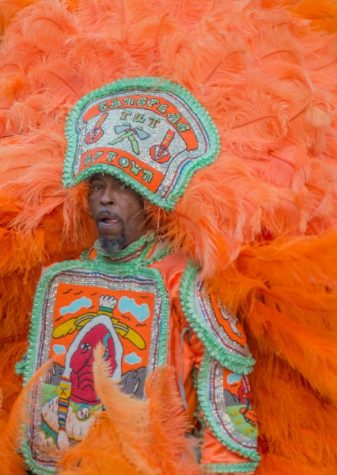Know Your NOLA: Mardi Gras Indians
February 14, 2019

In the sea of paper mache floats, beads and colorful costumes, it’s hard for anything to stand out against the parade pandemonium of festival season. Yet, somehow, it’s impossible to miss the Mardi Gras Indians, punctuating parades and festivals with bright suits adorned with stones and feathers.
While they are a fixture in Louisiana history and a common sight everywhere from Super Sunday to New Orleans Jazz and Heritage Festival, many students are unfamiliar with their rich heritage. Mardi Gras Indians are a lasting symbol of solidarity between people of color dating back as early 1718 in Louisiana’s history. Indigenous people supported and saved Afro-Caribbean victims of the transatlantic slave trade, forming a bond and blending cultures in a way that lives on through Mardi Gras Indians today.
Some assume Mardi Gras Indian tribes are simply a type of krewe, but this culture far predates them. In fact, while secret societies in the South have long existed, the first official krewe, Mystic Krewe of Comus, was not formed until 1857. Given that krewes did not desegregate until 1992, Mardi Gras Indian tribes were among the few social groups that not only allowed, but celebrated, Black people and culture in New Orleans.
The suits that identify a Mardi Gras Indian – brightly colored, beaded and framed by an enormous fringe of feathers – may seem characteristic of many indigenous American cultures but are actually traditional in West African culture, as well.
These suits, which are expensive and intricate to make, are often photographed and videotaped without permission from or payment to the Mardi Gras Indians themselves. Despite being recognizable far beyond Louisiana, having substantial roots in New Orleans’ culture and driving the city’s tourism industry, tribe members often go uncompensated for their contributions. In 2011, however, adjunct professor Ashlye Keaton worked with Tulane law students to gain Mardi Gras Indians copyright protections for their suits by categorizing them as works of art.
Recognizing the artistry behind Mardi Gras Indian costumes has helped raise awareness about who they are and what their history is. Today, Mardi Gras Indians are predominantly Black, working-class New Orleans natives, keeping long-standing traditions like performance through song and dance, costume competitions and rules of secrecy, alive over the years.
Masking, the yearly process of creating a new suit, is an incredibly private process, but their debut is often public for the world to enjoy. Super Sunday, which will take place March 17, is a parade and party hosted by various tribes that the greater New Orleans community is welcomed to attend.






















Leave a Comment